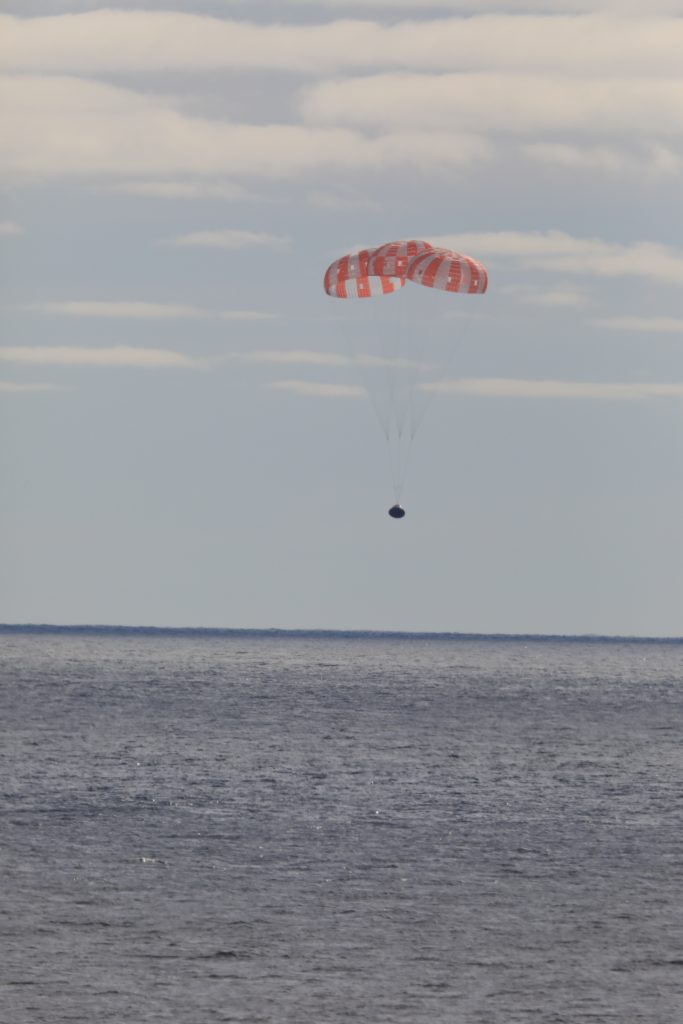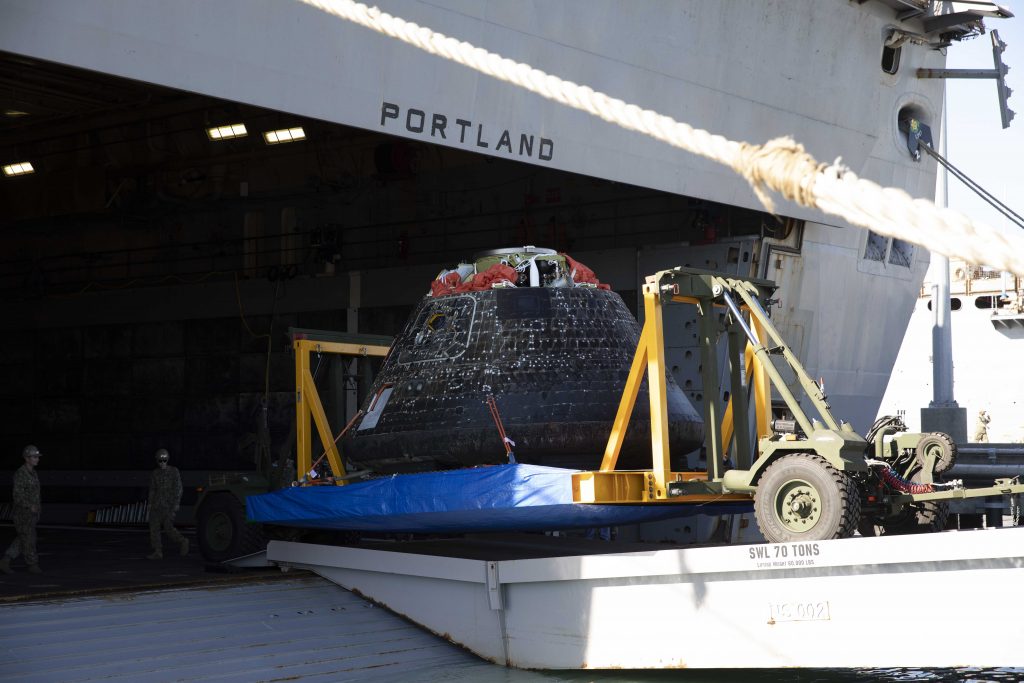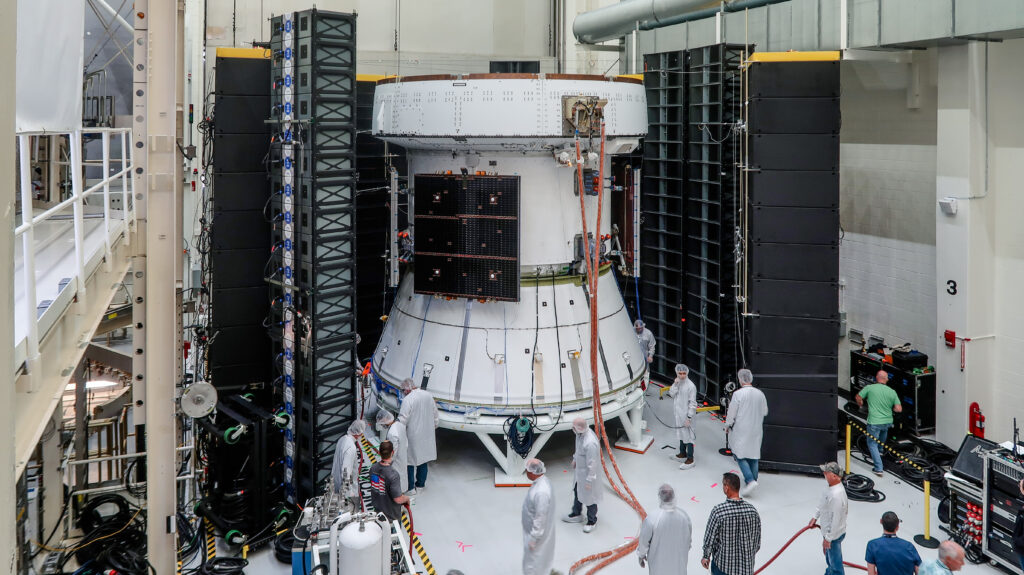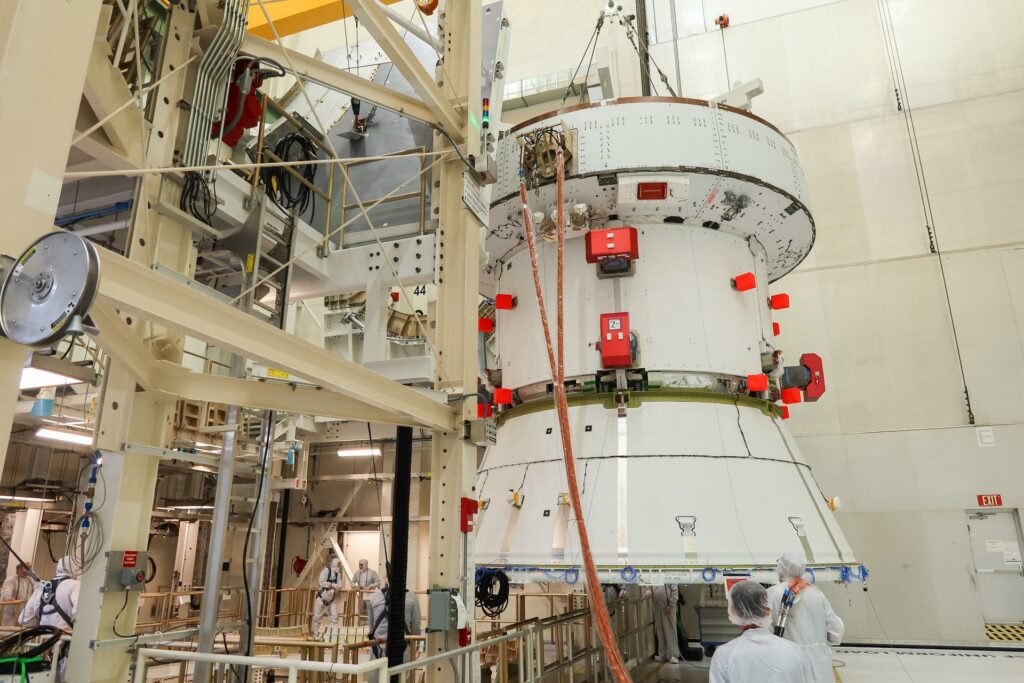Neues von der Artemis 1 - Mission:
Sun, 11 Dec 2022 17:01:25 +0000
Artemis
The crew module of NASA’s Orion spacecraft has successfully separated from its service module at 11:00 a.m. CST in preparation for the crew module’s return to Earth. The service module will burn up harmlessly in Earth’s atmosphere upon re-entry over the Pacific Ocean. The Artemis I trajectory is designed to ensure any remaining parts do not pose a hazard to land, people, or shipping lanes.
Next, the crew module will perform a skip entry technique, dipping into the upper part of Earth’s atmosphere and using that atmosphere, along with the lift of the capsule, to skip back out of the atmosphere, then reenter for final descent under parachutes and splash down. This technique enables the spacecraft to accurately and consistently splash down at the selected landing site for Artemis missions regardless of when and where they return from the Moon. During re-entry, the enormous heat generated as Orion encounters the atmosphere turns the air surrounding the capsule into plasma, which will briefly disrupt communications with the spacecraft.
Below are the upcoming re-entry milestones in CST:
11:20:14 p.m. – Crew Module Entry Interface
11:35:28 p.m. – Altitude 40,000 feet
11:36:02 p.m. – Forward Bay Cover Chute Deploy
11:36:06 p.m. – Drogue Chute Deploy
11:37:26 p.m. – Main Chute Deploy
11:39:41 p.m. – Splashdown
Earth’s atmosphere initially will slow the spacecraft to 325 mph, then the parachutes will slow Orion to a safe splashdown speed of 20 mph or less as it descends through Earth’s atmosphere. Parachute deployment begins at an altitude of about five miles with three small parachutes pulling the forward bay covers away. Once the forward bay cover separates, two drogue parachutes will slow and stabilize the crew module for main parachute deployment. At an altitude of 9,500 feet and a spacecraft speed of 130 mph, three pilot parachutes will lift and deploy the main parachutes to slow Orion to a landing speed that ensures astronaut safety for crewed missions.
When Orion splashes down, the crew module uprighting system, also known as CMUS, deploys a series of five bright-orange helium-filled bags on the top of the capsule to upright the capsule in the event it stabilizes upside down. The system will deploy regardless of the landing position of the capsule, and it takes less than four minutes to upright the capsule if needed. The capsule must be upright for crew module communication systems to operate correctly and to help protect the health of the crew members inside on future missions.
Siehe auch die Originalnachricht:
Artemis I – Flight Day 26: Orion Crew Module Separation From Service Module Complete – Artemis

 At 12:40 p.m. EST, Dec. 11, 2022, NASA’s Orion spacecraft for the Artemis I mission splashed down in the Pacific Ocean after a 25.5 day mission to the Moon. Orion will be recovered by NASA’s Landing and Recovery team, U.S. Navy and Department of Defense partners aboard the USS Portland ship. Credit: NASA/Kim ShiflettNASA’s Orion spacecraft
At 12:40 p.m. EST, Dec. 11, 2022, NASA’s Orion spacecraft for the Artemis I mission splashed down in the Pacific Ocean after a 25.5 day mission to the Moon. Orion will be recovered by NASA’s Landing and Recovery team, U.S. Navy and Department of Defense partners aboard the USS Portland ship. Credit: NASA/Kim ShiflettNASA’s Orion spacecraft  At 12:40 p.m. EST, Dec. 11, 2022, NASA’s Orion spacecraft for the Artemis I mission splashed down in the Pacific Ocean after a 25.5 day mission to the Moon. Orion will be recovered by NASA’s Landing and Recovery team, U.S. Navy and Department of Defense partners aboard the USS Portland. Credit: NASA/James M. Blair
At 12:40 p.m. EST, Dec. 11, 2022, NASA’s Orion spacecraft for the Artemis I mission splashed down in the Pacific Ocean after a 25.5 day mission to the Moon. Orion will be recovered by NASA’s Landing and Recovery team, U.S. Navy and Department of Defense partners aboard the USS Portland. Credit: NASA/James M. Blair Team members with NASA’s Exploration Ground Systems program successfully removed the Artemis I Orion spacecraft from the USS Portland Dec. 14, after the ship arrived at U.S. Naval Base San Diego.
Team members with NASA’s Exploration Ground Systems program successfully removed the Artemis I Orion spacecraft from the USS Portland Dec. 14, after the ship arrived at U.S. Naval Base San Diego. NASA’s Space Launch System rocket carrying the Orion spacecraft launches on the Artemis I flight test, Nov. 16, 2022, from Launch Complex 39B at NASA’s Kennedy Space Center in Florida. Photo Credit: (NASA/Joel Kowsky)
NASA’s Space Launch System rocket carrying the Orion spacecraft launches on the Artemis I flight test, Nov. 16, 2022, from Launch Complex 39B at NASA’s Kennedy Space Center in Florida. Photo Credit: (NASA/Joel Kowsky) Images of the permanently shadowed wall and floor of Shackleton Crater captured by Lunar Reconnaissance Orbiter Camera (LROC) (left) and ShadowCam (right). Each panel shows an area that is 5,906 feet (1,800 meters) wide and 7,218 feet (2,200 meters) tall. Image Credit: NASA/KARI/ASU
Images of the permanently shadowed wall and floor of Shackleton Crater captured by Lunar Reconnaissance Orbiter Camera (LROC) (left) and ShadowCam (right). Each panel shows an area that is 5,906 feet (1,800 meters) wide and 7,218 feet (2,200 meters) tall. Image Credit: NASA/KARI/ASU The European Service Module for the Artemis II mission is photographed inside the Neil Armstrong Operations and Checkout Building at NASA’s Kennedy Space Center in Florida while it was configured for acoustic testing. Photo credit: NASA/Amanda Stevenson
The European Service Module for the Artemis II mission is photographed inside the Neil Armstrong Operations and Checkout Building at NASA’s Kennedy Space Center in Florida while it was configured for acoustic testing. Photo credit: NASA/Amanda Stevenson Technicians at NASA’s Kennedy Space Center in Florida operate a 30-ton crane to lift and transfer the Orion spacecraft’s service module into the FAST (final assembly and system testing) cell on May 22, 2023, inside the spaceport’s Neil A. Armstrong Operations and Checkout Building.
Technicians at NASA’s Kennedy Space Center in Florida operate a 30-ton crane to lift and transfer the Orion spacecraft’s service module into the FAST (final assembly and system testing) cell on May 22, 2023, inside the spaceport’s Neil A. Armstrong Operations and Checkout Building. Installation of the heat shield for the Artemis II Orion spacecraft was recently completed at NASA’s Kennedy Space Center in Florida. Photo credit: NASA/Cory Huston
Installation of the heat shield for the Artemis II Orion spacecraft was recently completed at NASA’s Kennedy Space Center in Florida. Photo credit: NASA/Cory Huston From left (front to back), NASA astronauts Victor Glover, Christina Hammock Koch, and Reid Wiseman, along with Canadian Space Agency astronaut Jeremy Hansen, pose inside the Vehicle Advanced Demonstrator for Emergency Recovery (VADR) during a tour of Naval Base San Diego on July 19, 2023. VADR is a replica of the Orion crew module that will carry the astronauts around the Moon on Artemis II. Photo credit: U.S. Navy/Mass Communication Specialist 2nd Class Joshua Samoluk
From left (front to back), NASA astronauts Victor Glover, Christina Hammock Koch, and Reid Wiseman, along with Canadian Space Agency astronaut Jeremy Hansen, pose inside the Vehicle Advanced Demonstrator for Emergency Recovery (VADR) during a tour of Naval Base San Diego on July 19, 2023. VADR is a replica of the Orion crew module that will carry the astronauts around the Moon on Artemis II. Photo credit: U.S. Navy/Mass Communication Specialist 2nd Class Joshua Samoluk Artemis II crew members, shown inside the Neil Armstrong Operations and Checkout Building at NASA’s Kennedy Space Center in Florida, check out their Orion crew module on Aug. 8, 2023. From left are: Victor Glover, pilot; Reid Wiseman, commander; Christina Hammock Koch, mission specialist; and Jeremy Hansen, mission specialist. The crew module is undergoing acoustic testing ahead of integration with the European Service Module. Artemis II is the first crewed mission on NASA’s path to establishing a long-term lunar presence for science and exploration under Artemis. Photo credit: NASA/Kim Shiflett
Artemis II crew members, shown inside the Neil Armstrong Operations and Checkout Building at NASA’s Kennedy Space Center in Florida, check out their Orion crew module on Aug. 8, 2023. From left are: Victor Glover, pilot; Reid Wiseman, commander; Christina Hammock Koch, mission specialist; and Jeremy Hansen, mission specialist. The crew module is undergoing acoustic testing ahead of integration with the European Service Module. Artemis II is the first crewed mission on NASA’s path to establishing a long-term lunar presence for science and exploration under Artemis. Photo credit: NASA/Kim Shiflett Mobile launcher 1 is on its way to Launch Pad 39B at NASA’s Kennedy Space Center in Florida to prepare for Artemis ll, the first crewed mission on the agency’s path to establishing a long-term presence at the Moon under Artemis.
Mobile launcher 1 is on its way to Launch Pad 39B at NASA’s Kennedy Space Center in Florida to prepare for Artemis ll, the first crewed mission on the agency’s path to establishing a long-term presence at the Moon under Artemis.  The mobile launcher, carried by the crawler-transporter 2, rolls out from its park site location to Launch Pad 39B at NASA’s Kennedy Space Center in Florida on Aug. 16, 2023. While at the pad, it will undergo testing for the agency’s Artemis II mission. Under Artemis, the mobile launcher will transport NASA’s Space Launch System rocket and Orion spacecraft to pad 39B for liftoff. Photo credit: NASA/Ben Smegelsky
The mobile launcher, carried by the crawler-transporter 2, rolls out from its park site location to Launch Pad 39B at NASA’s Kennedy Space Center in Florida on Aug. 16, 2023. While at the pad, it will undergo testing for the agency’s Artemis II mission. Under Artemis, the mobile launcher will transport NASA’s Space Launch System rocket and Orion spacecraft to pad 39B for liftoff. Photo credit: NASA/Ben Smegelsky